Cereal is a popular crunchy, yet soggy, breakfast choice for many Australians. The phrase 'breakfast is the most important meal of the day' seems to be ingrained (pun intended) into everyone. So, if breakfast is so important, then the cereal we choose is equally important – especially when it comes to our health.
When faced with a supermarket aisle dedicated to cereal, the array of options makes choosing a healthy cereal for you and your family difficult. Let’s take a look at three popular household choices and how they stack up on the basis of health and nutrition.
| Cereal | Name | Description |
|---|---|---|
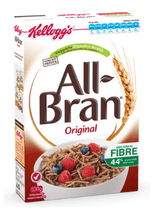 | Kellogg's All Bran | The natural wheat bran fibre found in Kellogg’s All-Bran is proven to help with regularity and has 44% of your daily fibre intake in one bowl. Tip: Add fruit or low fat yoghurt to sweeten the deal. |
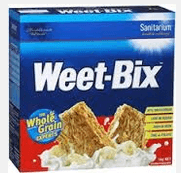 | Sanitarium Weet Bix | Weet-Bix is the breakfast of champions. Start your day right with this Aussie favourite. |
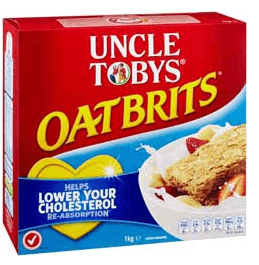 | Uncle Toby's Oat Brits | Uncle Tobys Oat Brits are made with quality Uncle Tobys wholegrain oats. Oats, are rich in beta-glucan, which can help lower cholesterol re-absorption. |
 | Kellogg's Crunch Nut | Are you a Kelloggs Crunchy Nut? This new twist on a classic breakfast cereal will have the whole family going nuts for breakfast. |
 | Kellogg's Nutri-Grain | Nutri-Grain is Iron Man Food. Nutri-Grain is made with corn, oats and wheat and is the original protein cereal. |
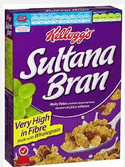 | Kellogg's Sultana Bran | Don't tell them it's healthy. Sultana Bran makes a healthy favourite a little sweeter, so you don't have to fight with your kids about the benefits of a healthy breakfast. |
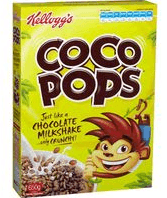 | Kellogg's Coco Pops | This kids favourite tastes just like a chocolate milkshake, only crunchy and is the perfect holiday treat. |
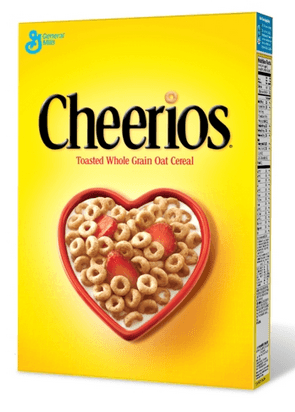 | Uncle Toby's Cheerios | Made from corn, wheat, oats and rice, Uncle Toby's Cheerios also has no artificial colours or flavours and is approved by National Heart Foundation. |
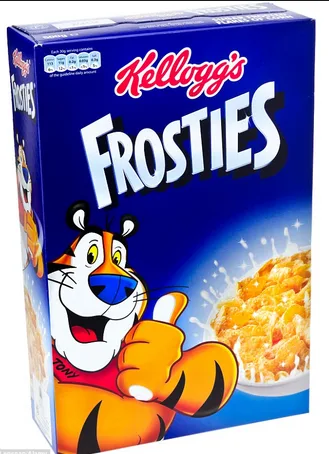 | Kellogg's Frosties | Kellogg's Frosties can be a sweet treat for you kids and are crunchy corn flakes with a coating of sweet frosting. |
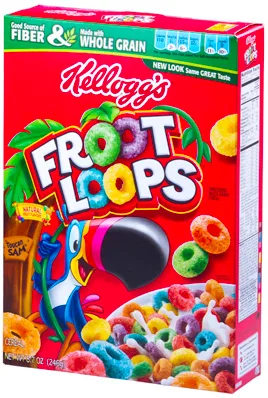 | Kellogg's Fruit Loops | If you're kids want to eat like Toucan Sam, Kellogg's Fruit Loops are the right choice. Kellogg's Fruit Loops are fruit-flavoured cereal rings of corn, wheat and oats. |
 | Kellogg's Special K | Special K is made from three grains of rice, wholewheat and oats. They are a great source of fibre and 99% fat free. |
 | Kellogg's Rice Bubbles | Take a journey with Snap, Crackle and Pop, next time you sit down to breakfast with Kellogg's Rice Bubbles |
Are you getting enough fibre in your cereal?
One of the first things you should look for when choosing a cereal is fibre. Fibre has the obvious digestive benefits but researchers have found that a diet high in cereal fibre reduces the risk of death from a number of chronic diseases including heart disease and diabetes. The recommended daily intake of fibre is 30g for an adult and dieticians suggest that you should be choosing a cereal that provides at least 7g per 100g.
- Frosties, a favourite with the kids and made with Tony the Tiger’s secret formula, weighs in with only 3g per 100g of your daily needs
- Weet-Bix, known for being the breakfast of champions is high in dietary fibre containing 11g per 100g
- Kellogg’s Sultana Bran contains 22% of your daily fibre intake with 14.4g to every 100g and as long as you don’t “mention it’s healthy they’ll eat it by the boxful”.
Do I need to eat whole grains?
It is also important to take into account how much whole grain is in your cereal. Many of us are eating way too many of the refined type. When choosing a cereal, you should look for one made with at least 50% whole grain ingredients. This will mean that they haven’t filled your cereal with refined whole grains that through extensive processing have lost their nutritional value.
- Weet-Bix stands out in this category as the healthy option boasting a huge 97% whole grain
- Sultana Bran falls behind the requirements with 38% whole grain
- Frosties fails to meet your whole grain needs at all.
How much is too much sugar?
Much of the recent focus on unhealthy cereals has been on their sugar content. However, the latest Australian Health Survey shows breakfast cereals contribute only 3% of the sugar in adult Australian diets. When choosing your cereal you should be keeping an eye on the added sugars. The levels of sugar should be less than 15g per 100g or less than 25g per 100g of total sugar if the cereal contains dried fruit.
- There may be a reason that Tony the Tiger has no teeth, with 41.3 grams of a 100g serving containing sugar
- Sultana Bran is full of dried fruit and therefore still falls within a healthy range having 22.7g per 100g
- Weet-Bix is the healthiest of the bunch again with only 3.3g of sugar per 100g.
Must read: Kellogg’s introduce voluntary Health Star Rating
Kellogg’s is implementing a voluntary Health Star Rating on its cereals in Australia and New Zealand. The ratings system will be featured on the front of Kellogg’s packaging from June 2015. It is being implemented as a way of assisting consumers determine the health benefits of a product. Cereals are assessed on sugar, salt and saturated per 100 grams. Accordingly, they are given a rating after such assessment. While this system will identify some popular cereals as unhealthy, it will also highlight healthier options, which make up more than 70% of their cereals. In doing so, this will assist shoppers, particularly parents, in making healthier decisions.
Which are the best and worst cereals?
Five of the healthiest cereals on the market
| Product | Health Star Rating | Brand | Total Fibre (g per 100g) | Sugars (g per 100g) | Sodium (g per 100g) |
|---|---|---|---|---|---|
Kellogg’s All-Bran original | 5 | All-Bran Original | 30 | 16.7 | 360 |
Sanitariums Weet-Bix Organic | 5 | Sanitarium | 11 | 2.9 | 270 |
Uncle Tobys Oat Brits | 5 | Uncle Tobys | 11 | 0.8 | 253 |
Uncle Tobys Shredded Wheat | 5 | Uncle Tobys | 13 | 2 | 10 |
Woolworths Select High Fibre Bran | 5 | Woolworths Select | 36 | 18.1 | 383 |
Five of the unhealthiest cereals on the market
| Product | Health Star Rating | Brand | Total Fibre (g per 100g) | Sugars (g per 100g) | Sodium (g per 100g) |
|---|---|---|---|---|---|
Woolworths Select Honey Nut Cornflakes | 2 | Woolworths Select | 3 | 34.5 | 330 |
Kellogg’s Nutri-Grain | 2 | Kellogg’s | 3 | 32 | 480 |
Kellogg’s Crunchy Nut | 2 | Kellogg’s | 3 | 31.7 | 375 |
Coles Honey Crunch | 2 | Coles | 3 | 42 | 123 |
Black&Gold Corn Flakes | 2 | Black&Gold | 2 | 10 | 744 |
Cornflake fun fact
Why is breakfast so important?
While most people believe that breakfast is the most important meal of the day and that skipping it will only have a negative influence on your health, there is research that supports either side of the argument. A number of studies indicate that skipping breakfast is more likely to cause you to be overweight or obese. Similar studies also suggest that kids will benefit from having a healthy breakfast, as they will be able to concentrate better in school.
On the other side of the argument there are people that say that skipping breakfast isn’t as a big a deal. There is some support for Intermittent Fasting (IF) where one eats only once a day. When it comes down to it, breakfast can be a major contributor to our daily nutrient intake requirements and, while skipping it may not lead specifically to obesity, if you eat the right breakfast you will be healthier for it.
One other school of thought on the eating breakfast takes a more pragmatic approach: if you’re hungry, eat. If you’re not, don’t.
How can I make sure my kids are starting the day right?
A healthy start to the day for kids can begin with a healthy breakfast. Choosing the right breakfast can be difficult. Here are three steps to help you pick a healthy and nutritious breakfast for your kids.
Step 1: Look at the nutrition panel
The nutrition panel provides information to determine which cereal is the right one for your child. In order to compare each cereal you should compare the per 100g column, as this provides the most accurate comparison between cereals. Here are the recommended intakes:
- Total Fat: Less than 10g and saturated fat less than 2g
- Sugar: Less than 15g, less than 25g for cereals containing dried fruit
- Dietary Fibre: More than 7.5g
- Sodium (salt): Less than 120mg
Step 2: Look at the ingredients list
The ingredient list can be a helpful and easy way of deciding on the right cereal. The ingredients are shown in descending order with the main ingredient listed first. If one of the first ingredients on the list is a source of sugar, fat or salt, you may want to try another option.
Step 3: Nutrition claims on cereal boxes.
Health claims on the front of a cereal box don’t necessarily mean that the cereal is healthy for your child. The claims can be misleading, below is a helpful table of what each of these claims actually means.
| Health Claim | What this means | Comments |
|---|---|---|
Source of fibre | This means the cereal contains at least 2g per serve | Worth consider but there are higher fibre choices. Look for claims stating ‘good source’ which contain at least 4g of fibre per serve; or ‘excellent source’ which contain at least 7g of fibre per serve |
Low in sugar | This means the cereal contains less than 5g of sugar per 100g | Worth considering |
No added sugar | Means no added sugar but may contain natural sugars from ingredients such as dried fruit | May be misleading so need to check the label for sugar content |
Lite or light | May refer to texture, colour or taste – not necessarily kilojoules or calories | May be misleading so need to check the label for sugar and fat content |
Low fat | Must contain less than 3g fat per 100g | Worth considering but doesn’t mean that it will meet all nutrient guidelines for cereals |
Wholegrain | There is no definition or standard for labelling % of whole grains | Worth considering but check the total fibre content of the product |
Cereal through the ages
Cereal was first invented around the American Civil war as many suffered from digestive problems due to a diet that was low in fibre and high in protein. Dr James Caleb Jackson developed a form of health food in his Sanitarium in New York, which was made by mixing water with graham flour and then baking it. This was considered to be the earliest form of cereal.
In 1875, at another sanitarium, a man named John Harvey Kellogg began making his own health food for his patients in Michigan by running boiled wheat through rollers to create a very thin cracker sheet. He roasted the sheet and ground it up. This went on to be known as granola.
The creation of the cornflake cereal we know and love today was actually a happy accident when a batch of boiled oats were left out over-night by Harvey and his brother Will. They decided to roll and bake the stale oats, which resulted in the first modern, ready-to-eat cereal, the Cornflake. This established the manufacturing model for modern cereal production turning it into the popular breakfast meal that a large portion of the world now eats.
Back to topAs Kellogg’s new rating system for cereals is released, this presents opportunities to look at inter-brand comparisons of cereals. Such a comparison can be conducted to include: fibre, whole grains, sugar content and sodium. This provides for opportunities to consider the nutritional value of cereals in light of its existence within cultural idioms. Contrary to its inception as a health alternative, cereal has evolved into a cultural staple.
More guides on Finder Shopping
-
Red Rooster ‘Rate Cut’ deal: 20% off Click & Collect ONE DAY ONLY!
Red Rooster is beating the RBA to it with a massive one-day-only discount on all your favourites.
-
Where to buy alcohol online in Australia
Whether you’re looking to stock up or you just want to source your favourite tipple, you’ll find it at one of these great retailers.
-
Best tequila in Australia
We’ve chosen the ten best tequilas available online—from the best one for margaritas to the top premium option.
-
Best cheap alcohol in Australia
We’ve found the 13 best cheap alcohol products you can purchase right now in Australia.
-
Best wine clubs and subscription services in Australia 2025
We’ve done the hard work to find the best wine clubs and subscription services for Australian wine drinkers.
-
Best champagne in Australia
These are the best champagnes in Australia based on expert research and hundreds of consumer reviews.
-
Where to buy ESE pods online in Australia
Here are the top online retailers that are selling your favourite espresso shots.
-
Where to buy hydrogen peroxide online in Australia
Used as everything from a stain remover to a mouth rinse, hydrogen peroxide is a staple household item. Here's where you can shop for it online.
-
Food and alcohol stores that offer Afterpay | Full list 2025
Hungry? Got a party coming up? Why not shop all your food and drink needs with Afterpay?
-
Where to buy supplements online in Australia 2025
Get ripped, not ripped off. We’ve found the best places to buy supplements online - and see where you can score free shipping.
